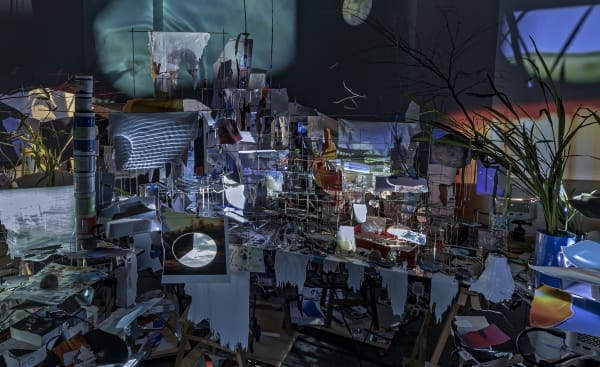Sarah Sze: Images in Debris: MOCA, Toronto
Sarah Sze’s Images in Debris is the first instalment of The City Is a Collection, a MOCA exhibition series that presents privately owned contemporary artworks from throughout the Toronto community.
Constellatory, monumental, intimate and immersive, Images in Debris is one in a series of sculptures by Sarah Sze where light, movement, images and architecture coalesce into a single, precarious equilibrium.
Simultaneously a sculptural installation and functional projection tool, Images in Debris lends equal weight to images and objects, exploring the edges between the two and bringing both into dialogue with the surrounding architecture. At its centre is an L-shaped desk, inspired by the artist’s own studio desk, which, acting like a projector at the centre of a planetarium, casts images onto an intricate structure extending from the desktop and across the gallery walls.
Scanning the architecture at different speeds, the projections alter our sense of gravity, scale and time. A site of both networked and fractured relationships, Images in Debris analyzes the ways in which we experience the image-saturated contemporary world. Poised at the intersection of the material and the virtual, it offers windows onto moments by turns public and private.
The imagery itself — much of it shot on the artist’s iPhone — often points to its own materiality or to changes in material state. A forest burns. Water spills or splashes — a reference to Harold Edgerton’s famous 1936 photograph Milk-Drop Coronet Splash and to the earlier experiments of Muybridge and Marey. Edits, meanwhile, draw attention to processes of decay or transformation, images succumbing to pixilation or becoming ghostly like digital “snow.” In tandem, altered states of consciousness are suggested by imagery that draws on such motifs as that of a child asleep. Within the slow loop of the imagery — in which repetitions take days rather than hours — beginnings and endings are willfully suspended. Here, Sze applies to sculpture the filmic idea of the edit, where meaning occurs in the splice, and the viewer, moving through the space, supplies their own narrative arc.



